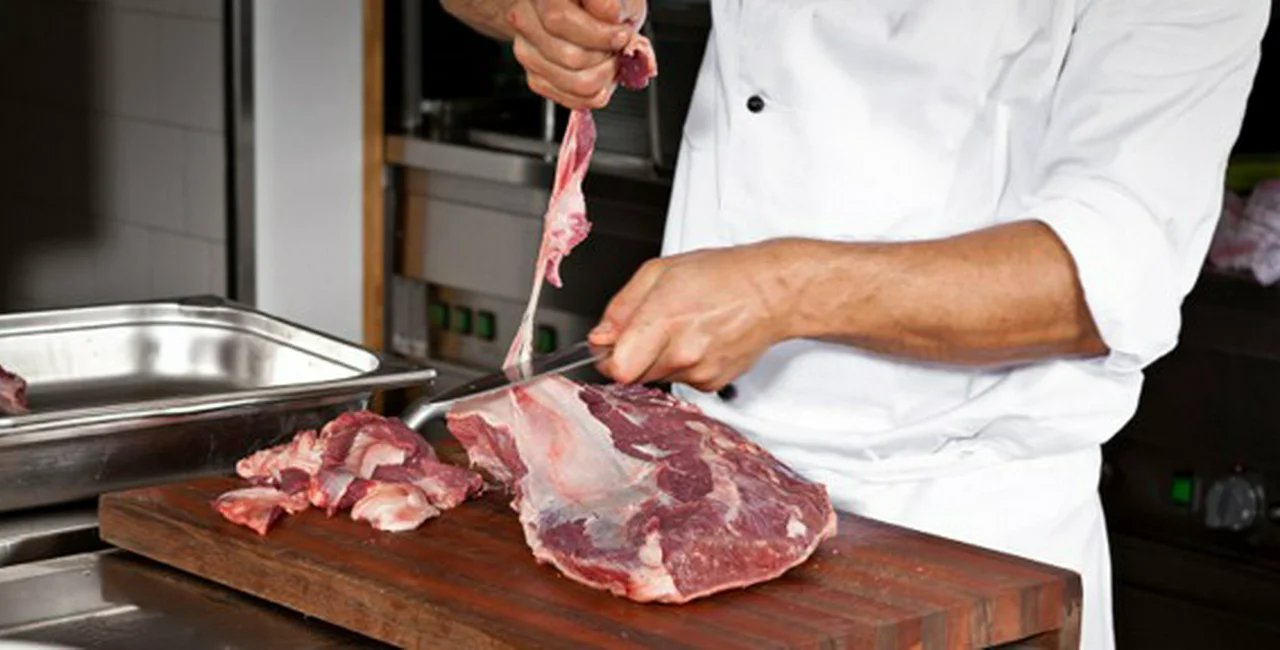Like many families who are health conscious, planet conscious, and watching money, my home meals are becoming more and more plant-based. But as a cook, I still want to be able to create excellent meat dishes. I appreciate a good steak on occasion, as a special treat. That’s why, if I’m going to prepare beef – it had darn well better be a real treat! If it isn’t, why bother? No one wants to serve hard and dry meat, but since coming to the Czech Republic, that’s been the result every time.
Now, I’m no chef, but I had no trouble making juicy fajitas and tender beef teriyaki back home. But here? Mince meat and sausage turn out alright, but as for anything else – let’s just say we give it to the stray cat who lives near our house. And even he walks away.
In this article I’ll point out some differences between US beef and local beef and give some tips to help you make your beef that much better.
Maybe this has happened to you: you’re at your local grocer and decide you want a piece of meat for dinner. You eye the various cuts of beef, packed in Styrofoam and plastic. Unfamiliar names like “přední” and “kýta” swim before your eyes. Everything’s the same color, in somewhat different shapes. You grab something, not knowing what it is, take it home, throw it onto a pan or grill and – blech. It’s not just that we don’t understand the names, it’s that the kinds of meat for sale are different than what we’re used to. Half the things on the shelf wouldn’t be available in a typical US retail environment – because there’s just no demand for it.
When it comes to meat, the quality of the cut is most important, and svíčková is the best. Svíčková is something you can find in meat departments of bigger stores and local butchers, unless, of course, it’s sold out, which seems to happen a lot. For all your western cuisine dishes, start out by buying only svíčková and spare yourself disappointment. I’d been avoiding it because it cost a lot for something I knew I would just end up ruining – but it first was when I bought svíčková that I had good results.
I tested two kinds from Billa to compare. First, Billa’s own brand of Bio – Naše Bio svíčková and Maso Planá brand.
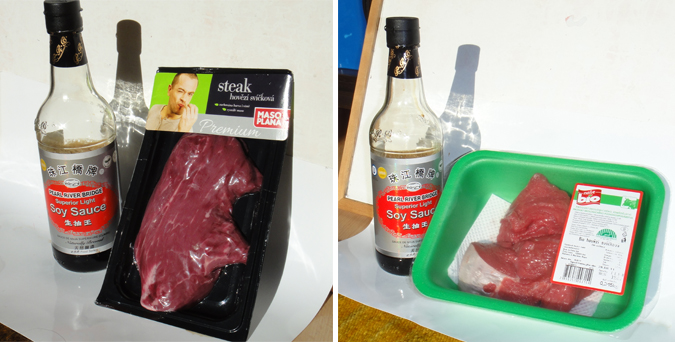
After marinating them an hour in soy sauce, I threw them onto a hot griddle, 3 minutes on each side, and was amazed. This was restaurant-quality steak – as tender, juicy, and flavorful as any I had yet tried in Prague. I couldn’t detect any noticeable difference in taste; the bio was more expensive, but less guilty. And suddenly the price seemed low, compared to what you would pay in a steakhouse. So yes, there is hope – but what about all that other cheap meat?
I’ve tried everything with my cheap cuts: hammering them with a mallet, marinating overnight – nothing made any difference. I even asked American visitors to bring a tenderizer with them – plant derived enzymes that break proteins down. The only thing that really makes a difference is cooking meat right: tough cuts need to be slow-cooked at a low temperature. And anything that isn’t labeled svíčková is basically going to be a tough cut.
Here is a diagram of how a cow is butchered in the US versus in the Czech Republic:
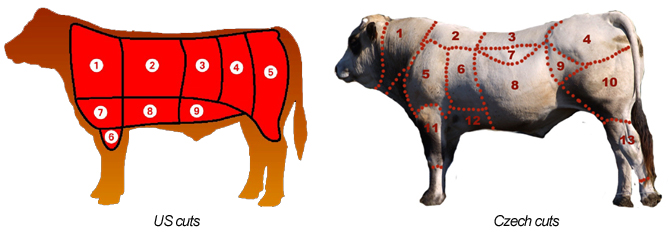
You can see how cows are divided along different lines. The USA has more specific classifications for the better cuts, and the rest are basically relegated to pet food. Finding a “brisket” (the front shoulder part) in America is hard because people just don’t want it. The Czech Republic uses more parts of the cow, but doesn’t distinguish between T-bone, tenderloin, round or top sirloin. Instead, commercial beef is labeled either as přední (front), zadní (rear), or svíčková. The other words on the label have more to do with the shape of the cut (medaillonky) or recommended use (na guláš).
The rule of thumb with beef is: the closer to the back of animal – especially if it’s towards the top of the body – the more tender the meat. These are the best cuts. Czechs don’t use a sub-classification like “prime” “choice” or “standard”, as is common in the States. Anything on the lower half of the cow or towards the front will be tough. That’s because the cow gets less exercise there, and that means less blood flow, more collagen – resulting in tough meat.
So the takeaway, and I wish I’d known, is that if you buy anything like “krk” (neck), “bok” (flank), “plec” (shoulder) or “kližka” (shin), you have to cook it very slowly over low heat. You want to melt the collagen – turning it into gelatin – and reduce moisture loss; particularly helpful is moist heat (broiling, stewing) as opposed to dry heat (grilling). If the heat is high, proteins will harden and expel the moisture. You can’t salvage the meat after that happens; more on how to cook inferior meat below.
Here is a comprehensive translation of the cuts:
Note: s.k. means s kostí (with bone), b.k. means bez kosti (without bones)
Prime rib steak -> vysoký roštěnec s.k.
Rib eye steak -> vysoký roštěnec b.k.
Strip Loin steak -> nízký roštěnec b.k. s povrchovým lojem a bočním svalem
Rump steak -> roštěnec b.k.
T-bone steak -> roštěnec a svíčková s.k.
Flank steak -> z pupku
Sirloin tip steak -> z přední kýty
Sirloin steak -> ze špičky
Inside round steak -> z vrchního šálu
Ford roast -> vysoký roštěnec b.k.
Prime rib roast -> vysoký roštěnec s.k.
Sirloin up roast -> z přední kýty
Inside round roast -> z vrchního šálu
Eye of round roast -> z válečku
Outside round roast -> ze spodního šálu
Shoulder clod -> z plece
Chuck roast boneless -> z předního b.k.
Blade roast -> z předního b.k.
Osso bucco -> kližka s.k. – plátky
This chart uses UK butcher terms because it was compiled by local (English) master butcher Chris Robertson of Robertson’s. Readers who don’t care about the technicalities of local meat but just want quality meat from a trustworthy source – who speaks their language – need look no further than his four shops. Robertson is well-known to all in search of the best sausage or certain hard-to-find British groceries.
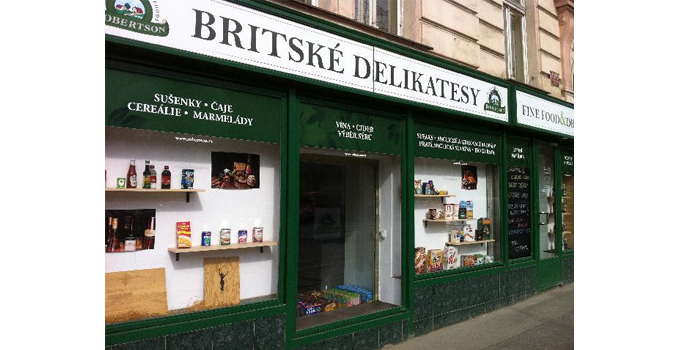
There’s a world of difference just between UK cuts and America. What Americans call “sirloin”, Brits would call “rump steak” – and the top round is called “silverhouse”. What a Brit would call “Sirloin” is called “Porterhouse” in the States. American “Tenderloin”, however, is just called fillet (rhymes with millet) in the UK, which is very confusing as many countries call any boneless piece of meat a fillet (pronounced: fill-ay). Meanwhile, such a “fillet” is called – in this country – STEAK. On Prague menus you see kuřecí steaky, vepřové steaky – anything that ever lived can be a steak. But if you want actual steak? Ask for the biftek.
Corn-fed vs Grass-fed
Americans may notice a different taste in European beef. US prime beef is mostly corn-fed, unless otherwise labeled. It’s a small but growing trend to graze cows on grass. European beef is mostly all grass-fed. Some of the benefits of grass-feeding include: no traces of hormones or antibiotics, fewer calories, more omega 3, and no risk of mad cow disease. Feed lot corn-fed cows are raised in dusty, crowded areas and many cows never see a blade of grass their whole life.
Source
Beef cattle vs. Dairy cattle
Cattle in the US is raised primarily for the beef. But in Europe, most cows are dairy cows. The meat from cows bred specifically for milk production isn’t as good, and there’s less of it. However, there are exceptions. According to Chris Robertson, “many countries rear beef cattle for beef production, especially the UK, Ireland, France, and Belgium. Even here in CZ there are specialist beef cattle farms working with breeds like Aberdeen Angus, Hereford, Charolais, and more.” If you want local “designer” beef you’ll have to visit a special butcher, as you’re likely to find it neither at the hypermarket nor the corner shop.
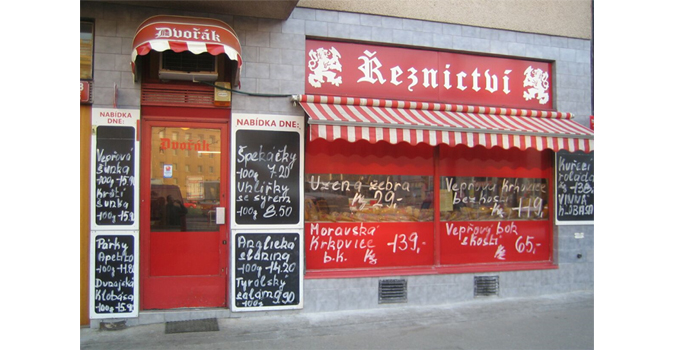
Traditional Czech řeznictví
Cow cheeks – For real?
For newcomers, restaurant menus provide endless entertainment, but it’s hard to tell when you’re looking at a poor translation or just strange food you’ve just never heard about. Take cow cheek, for example. That’s not a typo. But there is a movement afoot in the states called Nose to Tail Eating. The chefs who propagate it believe it’s disrespectful to toss the non-prime parts of the carcass away when you can try to create food from it. So eating weird body parts is trending, and the Czech Republic, home of the smoked pork knee and dršťková, is ahead of the curve, having never abandoned such practices in the first place. More on Nose to Tail Eating here.
Eating “Nose-to-Tail” appeals to the kind of adventurous eaters who seek out monkey brains and snake meat. For chefs, it is a chance to show off their talent – it takes skill and ingenuity to make eyeballs taste good. And morally, it’s less reprehensible to kill if you make use of every part of the animal, as indigenous tribes have done for centuries out of necessity. So I won’t scoff at the many packages of kližka (lower shin meat) anymore (Though it does seem to take up a disproportionately large amount of shelf space).
Making the Best of the Worst
There is a splendid invention called the Crock Pot, or slow cooker. This plug-in pot heats food up just a bit, over a long time (think 8-12 hours) in a sealed environment that preserves moisture. It literally transforms inedible cuts to fine, succulent meat. I’m a huge fan of mine, anyway, because you can be so much more spontaneous when you don’t have to hurry home to get dinner going. But another benefit, especially here, is its ability to transform the worst cuts of meat into tasty morsels. Just throw them in with a few onions and potatoes, and 6 hours later – hearty beef stew, where the beef strings come apart at the touch of a fork. I’ve managed to turn bad cuts of meat into beef stroganoff, beef bourgignon, and Thai beef for salads. If you don’t have a crock pot, you can braise or stew, just remember: low and slow.
Related articles
- Farewell Fake Rum? A Short History of the Endangered Czech Spirit
- Cocktail Emporium with Prague-Themed Drinks Opens on Wenceslas Square
- Prague Named among Top 10 Vegan-Friendly Capitals In 2017
- Czech Republic Will Continue to Fight Inferior Food Quality
- Take a Look Inside Prague’s New Temple For Meat Lovers












 Reading time: 8 minutes
Reading time: 8 minutes 